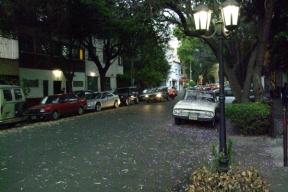 Early one evening in March 2009 I was walking through Mexico City with Mike Harrison, when we passed a side-street where many cars were parked in the deepening shadows of the trees. Mike and I had previously noted the profusion of flowering jacaranda trees in the city – in this road one of the trees had shed most of its flowers on a white Ford car parked beneath it. Mike, who was temporarily without his camera, asked me to take a shot of it. After we had returned to England I sent Mike a copy of the picture, which because of the low light turned out to be fairly grainy. I think the grain enhances the atmosphere.
Early one evening in March 2009 I was walking through Mexico City with Mike Harrison, when we passed a side-street where many cars were parked in the deepening shadows of the trees. Mike and I had previously noted the profusion of flowering jacaranda trees in the city – in this road one of the trees had shed most of its flowers on a white Ford car parked beneath it. Mike, who was temporarily without his camera, asked me to take a shot of it. After we had returned to England I sent Mike a copy of the picture, which because of the low light turned out to be fairly grainy. I think the grain enhances the atmosphere.
A year later, while drafting my novel The Islanders, I began to think of ways in which certain scenes in the novel could be illustrated. I looked through my collection of photographs to see what might be possible. The M. John Harrison Jacaranda, as I’ll always think of it, quickly suggested itself as an illustration of part of Muriseay Town, the largest city on the Dream Archipelago island of Muriseay.
‘Muriseay Town’ is not Mexico City except in parts: the vast spread of Muriseay’s shanty-town suburbs could come from Mexico City, but also from other places I’ve seen. In my images of Muriseay there are memories and imaginings of Athens, Paris, Yekaterinburg, London, Kuala Lumpur, Houston and many other big cities and ports, all jumbled up together. In the same way, the Archipelago itself is not a transplant from a single place, but is an amalgam. You can find archipelagian images and recollections of Guernsey and Sark, the Greek islands, Harrow-on-the-Hill, the French Riviera, the Harz mountains in Germany, Hastings, the Pennines, even Dartmoor and the Isle of Wight. I have many memories and a few photos of all those places and others, a kind of literal or codified memory, not at all the same thing as an imagined landscape, but an interesting parallel vision.
As I went on with the novel I found ways of manipulating many of these images, linking them to certain scenes in the book and captioning them with relevant text. The novel deals with the work of a particular novelist, so I decided to design and include some book jackets for him; as other writers came into the story, they too had covers designed for them. It’s the sort of literary displacement activity that’s almost as rewarding as writing the novel, but much less hard work.
I call the finished collection The Islanders Gallery. If it interests you and you would like to find out more about it and perhaps get hold of a copy, see the GrimGrin page on this site.